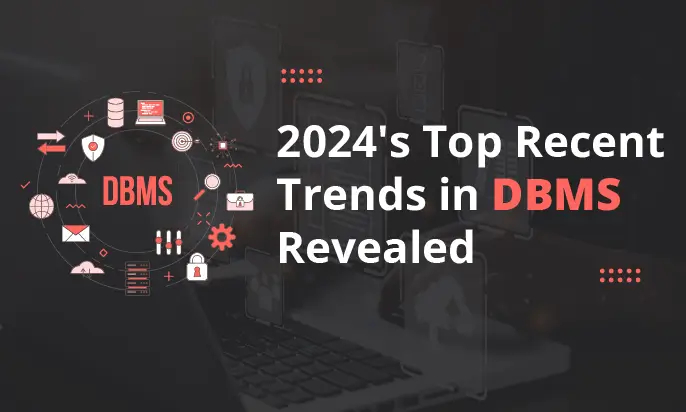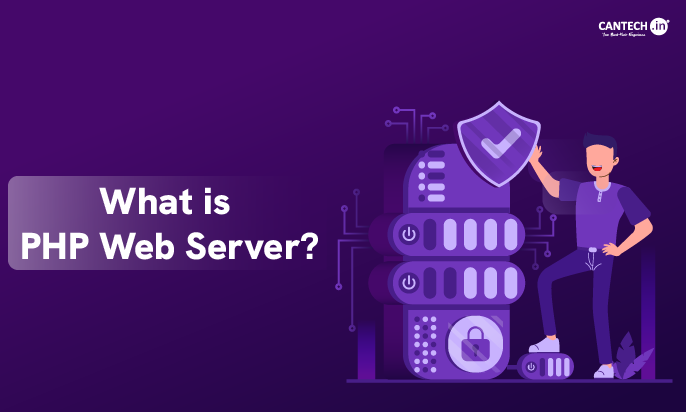In this section, we will explore the top recent trends in DBMS for the year 2024. Get ready to uncover the latest advancements in database management and stay ahead of the curve!
Key Takeaways:
- Stay updated on the recent trends in DBMS to enhance your database management capabilities.
- Embrace cloud-native DBMS for efficient and scalable database solutions.
- Explore the power of augmented analytics and AI in improving data analysis.
- Discover the importance of IoT integration in managing vast amounts of IoT data.
- Explore the potential of blockchain technology in enhancing data security and integrity.
What is Database Management?
Modern times emphasize data. This importance has made it essential to manage and organize huge data for business operations so that they can make informed decisions. So, what is database management system? Well, it is to store & maintain data systematically with specialized tools known as Database Management System (DBMS). They help structure the data so that you can easily access, analyze, and use it in making business strategies.
However, it is not enough to only possess large volumes of data. The real challenge lies in its effective management. With so much daily data creation, the use of a popular DBMS is important to ensure that businesses can store and analyze secure data for the best decision-making.
Moreover, data becomes reliable and up-to-date with database management systems. It also becomes readily available for analysis. Businesses can boost productivity and operational efficiency. The diverse features and new database management trends offered by different DBMS solutions make it essential for businesses to evaluate and select a system that best aligns with their specific needs.
Read More: What is VPS Hosting?
What Are the Benefits of Database Management System?
A Database Management System (DBMS) is a critical part of the modern business environment. It renders a structured approach to managing data. The benefits of utilizing a DBMS are so many. Mainly, it contributes significantly to improved efficiency and data security. Emerging databases have given rise to new database trends using top DBMS.
Data Reliability
A robust DBMS ensures the integrity and accuracy of data. It makes this possible by minimizing errors and providing consistent data management. This reliability is crucial for businesses that rely on precise data to align with emerging trends in databases and stay competitive in the market.
Data Visibility
Businesses can enhance the visibility of their data assets with a DBMS. Thus, it becomes easier to locate and analyze information. The adoption of automated database management systems further improves end-to-end data visibility and businesses gain valuable insights quickly.
Data Security
Your data management must be secure and a well-implemented database management system ensures that data is protected from unauthorized access and cyber threats. Also, sensitive data must be securely backed up and can be recovered when needed.
Scalability and Flexibility
Data needs also expand with the scaling of the businesses. Cloud-native databases and hybrid database management systems are the current trends in DBMS. They offer high scalability. They allow companies to efficiently manage increasing data volumes without compromising performance.
Data Sharing and Integration
A DBMS facilitates easy sharing and integration of data across different departments within an organization. This capability is essential for maintaining consistency and ensuring that data-driven decisions are based on comprehensive and up-to-date information. It helps with the automation to resolve and coordinate data.
Cloud-Native Database Management Systems
Cloud-native database management systems (DBMS) have emerged as a game-changer in the world of data management. With the increasing adoption of cloud computing in DBMS, organizations are experiencing significant transformations in the way data is handled and processed.
The benefits of cloud-based DBMS solutions are numerous. They provide scalability, flexibility, and cost-effectiveness, allowing businesses to easily scale their database infrastructure based on their needs and only pay for the resources they use. By leveraging the power of the cloud, organizations can eliminate the need for on-premises hardware and reduce maintenance costs.
Cloud-native DBMS also enable seamless integration with other cloud-based services, such as analytics tools and machine learning platforms. This integration empowers organizations to leverage advanced data analysis techniques, uncover valuable insights, and make data-driven decisions.
The shift to cloud-based database management is not only transforming the way organizations handle their data, but it is also revolutionizing the way businesses operate. By leveraging the cloud, organizations can achieve greater agility and responsiveness, as well as facilitate collaboration and real-time data sharing among teams located in different geographical locations.
“Cloud-native database management systems provide organizations with the agility, scalability, and cost-efficiency needed in today’s rapidly evolving business landscape.”
As organizations continue to harness the power of cloud-native DBMS, they are poised to gain a competitive edge in the market. By embracing cloud-based database management, businesses can unlock the full potential of their data and drive innovation.
Augmented Analytics in DBMS
When it comes to data analysis in DBMS, organizations are embracing a new frontier – augmented analytics. Powered by artificial intelligence (AI), augmented analytics enhances the capabilities of traditional data analysis methods, enabling organizations to gain valuable insights from their data like never before.
With AI-powered database management systems, businesses can now automate complex data analysis tasks, uncover hidden patterns, and generate actionable insights. By leveraging machine learning algorithms and natural language processing techniques, augmented analytics simplifies the data analysis process and enables users to make informed decisions quickly.
The Benefits of Augmented Analytics in DBMS
Augmented analytics offers several benefits to organizations, revolutionizing the way they leverage their data:
- Enhanced Speed and Efficiency: AI-powered DBMS accelerates the data analysis process, reducing the time and effort required to derive insights. Real-time analysis allows organizations to react swiftly to changing market conditions and gain a competitive edge.
- Improved Accuracy: By eliminating human bias and errors, augmented analytics ensures more accurate analysis and data-driven decision-making. AI algorithms can handle large datasets and detect intricate patterns that may be overlooked by human analysts.
- Discovering Unseen Insights: Augmented analytics uncovers hidden insights from complex and diverse datasets, enabling organizations to make data-driven decisions based on a holistic understanding of their data.
- Democratized Data Analysis: With augmented analytics, even non-technical users can access advanced data analysis capabilities. The intuitive interfaces and automated processes make it easier for business users to explore and interpret data.
AI and Data Analysis: A Powerful Combination
“Augmented analytics represents the next evolution of data analysis in DBMS. By harnessing the power of AI, organizations can unlock the full potential of their data and gain valuable insights that drive growth and innovation.”
The integration of AI-powered database management systems with augmented analytics is transforming the way organizations analyze and utilize their data. By leveraging AI algorithms, businesses can dig deeper into their data, spot trends, and make informed decisions faster and more confidently.
As the demand for data-driven insights continues to grow, augmented analytics presents an exciting opportunity for organizations to harness the power of AI and unlock the value hidden within their data.
Read More: What is Linux VPS Hosting?
IoT Integration in DBMS
In today’s interconnected world, the Internet of Things (IoT) is generating vast amounts of data that hold immense potential for businesses. However, efficiently managing and processing this data requires advanced database management systems (DBMS) that can seamlessly integrate IoT technologies.
IoT integration in DBMS is enabling organizations to harness the power of IoT data and leverage it for intelligent decision-making, process optimization, and innovative service offerings. By combining IoT devices, sensors, and data streams with DBMS capabilities, businesses can transform raw data into valuable insights and actionable information.
Benefits of IoT Integration in DBMS
- Real-time Data Processing: IoT integration in DBMS enables real-time data ingestion, processing, and analysis, allowing businesses to make instant decisions based on up-to-date information.
- Scalability: DBMS for IoT can handle the massive volumes of data generated by IoT devices, providing scalable storage and processing capabilities to meet the demands of IoT deployments.
- Data Consolidation: IoT integration in DBMS facilitates the consolidation of data from various sources, making it easier to store, access, and analyze data from diverse IoT devices and systems.
- Advanced Analytics: By integrating IoT data with DBMS, organizations can apply advanced analytics techniques, such as machine learning and artificial intelligence, to gain deeper insights and derive valuable predictions.
IoT integration in DBMS is not only transforming the way organizations manage and analyze data but also revolutionizing entire industries. From manufacturing and healthcare to transportation and agriculture, the potential applications of IoT-enabled DBMS solutions are endless.
“IoT integration in DBMS is a game-changer for businesses, enabling them to unlock the full potential of IoT data and drive innovation in their operations.”
The Future of IoT Data Management with DBMS
As IoT continues to grow and evolve, the role of DBMS in managing IoT data will become even more critical. DBMS for Internet of Things will need to adapt to handle the increasing complexity and velocity of IoT data, as well as ensure the security and privacy of sensitive information.
By utilizing IoT integration in DBMS, organizations will be able to harness the power of IoT-generated data to fuel their digital transformation initiatives, optimize operations, and deliver personalized experiences to customers. Whether it’s in the context of smart cities, connected vehicles, or industrial automation, DBMS will play a pivotal role in shaping the future of IoT data management.
| Challenges | Solutions |
|---|---|
| Data Volume | Scalable storage solutions and distributed DBMS architectures can handle the large volume of data generated by IoT devices. |
| Data Velocity | In-memory DBMS and real-time data processing technologies enable the efficient management and analysis of high-velocity IoT data streams. |
| Data Variety | Flexible DBMS architectures, such as multi-model databases, support different data types and models, allowing for seamless integration of diverse IoT data sources. |
| Data Security | Implementing robust security measures, including encryption and authentication protocols, ensures the protection of IoT data within DBMS systems. |
Blockchain Technology in DBMS
Blockchain technology has emerged as a game-changer in the world of database management systems (DBMS). This revolutionary technology has the potential to transform data security and integrity, providing a decentralized approach to storing and managing data.
By leveraging blockchain in DBMS, organizations can achieve secure data storage that is resistant to tampering, unauthorized access, and data breaches. The decentralized nature of blockchain ensures that data is distributed across multiple nodes, making it difficult for hackers to compromise the entire system.
One of the key advantages of blockchain-powered DBMS is its ability to establish trust and transparency in data transactions. Each transaction recorded on the blockchain is immutable, creating an auditable and trustworthy trail of data activities. This not only enhances data integrity but also facilitates regulatory compliance.
Blockchain technology in DBMS enables organizations to establish trust, enhance data security, and ensure transparent transactions.
In addition to secure data storage and transparent transactions, blockchain-powered DBMS can also improve data access and sharing. With blockchain, organizations can securely share data with authorized parties, streamlining processes and enhancing collaboration.
Furthermore, the integration of blockchain technology in DBMS opens up new possibilities for data monetization. As blockchain facilitates the creation of decentralized marketplaces, organizations can securely sell or exchange their data, unlocking its value and creating new revenue streams.
Benefits of Blockchain in DBMS
The adoption of blockchain technology in DBMS provides several benefits:
- Enhanced data security and integrity
- Decentralized and tamper-proof data storage
- Transparent and auditable data transactions
- Streamlined data access and sharing
- Potential for data monetization
By embracing blockchain technology in DBMS, organizations can ensure secure and reliable data management while exploring new possibilities for collaboration and innovation.
Graph Database Management Systems
Dive into the world of graph database management systems (graph DBMS) and unlock the power of efficient representation and analysis of interconnected data. Unlike traditional relational databases, graph DBMS leverage the concept of nodes and edges to model complex relationships and drive insights.
Graph-based data modeling forms the foundation for this innovative approach, allowing organizations to capture relationships seamlessly. Nodes represent entities such as customers, products, or locations, while edges characterize the connections between them. For example, in a social media network, a node could represent a user, and an edge would signify a friendship or follow relationship.
The unique properties of graph DBMS enable queries and traversals that efficiently uncover patterns and relationships within datasets. Graph algorithms play a key role in this process by providing computational methods to analyze and leverage the interconnected nature of the data. These algorithms allow for tasks such as pathfinding, community detection, recommendation systems, and fraud detection.
Applications of Graph DBMS
Graph database management systems find applications across various industries, empowering organizations to derive meaningful insights from their interconnected data. Here are some notable use cases:
- Social Networks: Graph DBMS excel in modeling social relationships, enabling platforms to analyze connections, suggest friends, and personalize content.
- Recommendation Engines: By leveraging graph algorithms, DBMS can generate accurate recommendations based on user preferences and item associations, improving customer experiences.
- Logistics and Supply Chain: Graph DBMS can optimize route planning, supply chain management, and vendor relationships by representing dependencies and identifying bottlenecks.
- Fraud Detection: Uncovering suspicious patterns and identifying fraudulent activities is enhanced through the powerful graph-based data modeling and graph algorithms utilized by graph DBMS.
Ready to explore further?
| Benefits of Graph DBMS | Challenges of Graph DBMS |
|---|---|
|
|
When considering the adoption of a graph DBMS, it is crucial to evaluate both the benefits and challenges specific to your use case and dataset. Harnessing the power of graph-based data modeling and graph algorithms can be a transformational step for organizations seeking to unlock deeper insights from their interconnected data.
Real-Time Data Processing and Analytics
In today’s fast-paced business environment, real-time data processing and analytics play a pivotal role in enabling organizations to make informed decisions quickly. The ability to gather, process, and analyze data in real-time provides valuable insights that drive business growth and competitive advantage.
One of the key technologies that empower real-time data processing and analytics is in-memory database management systems. These systems store data in the main memory (RAM) of the computer, allowing for faster data retrieval and processing compared to traditional disk-based databases.
In-memory database management systems leverage the power of RAM’s high-speed access to provide instant analytics capabilities. Queries and computations can be executed directly on the data in-memory, eliminating the need for time-consuming disk I/O operations. This enables organizations to gain real-time insights into their data, enabling faster decision-making and improved operational efficiency.
With the increasing volume, velocity, and variety of data being generated today, the ability to process and analyze data in real-time is crucial. Real-time data processing allows organizations to respond quickly to changing market conditions, identify opportunities, detect anomalies, and mitigate risks in a timely manner.
By leveraging in-memory database management systems, organizations can achieve:
- Instantaneous data analysis: The ability to perform complex queries and computations on large datasets in milliseconds.
- Improved operational efficiency: Real-time data processing enables organizations to identify bottlenecks, optimize workflows, and streamline operations.
- Enhanced customer experience: Real-time analytics facilitates personalized and targeted interactions with customers, resulting in improved customer satisfaction and loyalty.
- Real-time decision-making: Access to up-to-date information allows organizations to make data-driven decisions in real-time, minimizing the risk of making decisions based on outdated or incomplete data.
“Real-time data processing and analytics are revolutionizing the way organizations harness the power of data. With in-memory database management systems, businesses can unlock the potential of instant analytics, enabling faster and more efficient decision-making.”
“Real-time data processing and analytics are revolutionizing the way organizations harness the power of data.”
Overall, real-time data processing and analytics, powered by in-memory database management systems, empower organizations to stay agile, competitive, and responsive in today’s dynamic business landscape. By harnessing the power of real-time data, organizations can uncover valuable insights and drive innovation, ultimately paving the way for success in the digital age.
| Benefits of Real-Time Data Processing and Analytics |
|---|
| Instantaneous data analysis |
| Improved operational efficiency |
| Enhanced customer experience |
| Real-time decision-making |
Hybrid Database Management Systems
In the world of database management systems (DBMS), hybrid solutions have emerged as a powerful and flexible option. A hybrid DBMS combines the best features and capabilities of different types of DBMS, offering organizations a comprehensive solution to handle diverse data structures and optimize performance.
One of the key advantages of a hybrid DBMS is its ability to support hybrid data storage. This means that it can efficiently handle different types of data, whether structured, semi-structured, or unstructured, without sacrificing performance or scalability. By integrating various data models, such as relational, document-oriented, graph, and key-value, a hybrid DBMS enables organizations to seamlessly manage their multi-model data requirements.
“Hybrid DBMS allows businesses to unify their data across various models, eliminating the need for multiple specialized databases and simplifying data management workflows.”
Furthermore, a hybrid DBMS offers the flexibility to choose the most suitable storage technology for different data workloads. For example, frequently accessed data can be stored in-memory for faster retrieval, while less frequently accessed data can be stored on disk for cost-effectiveness. This intelligent data placement minimizes latency and optimizes resources, ensuring efficient and responsive data processing.
Let’s take a closer look at the advantages of a hybrid DBMS:
- Flexibility: A hybrid DBMS provides the flexibility to handle diverse data structures, allowing organizations to adapt to evolving data needs.
- Performance: By leveraging the strengths of various DBMS models, a hybrid solution delivers high-performance data processing and analytics.
- Scalability: With built-in scalability, a hybrid DBMS can effortlessly handle growing data volumes and support increasing workloads.
- Cost-effectiveness: By optimizing data storage based on usage patterns, a hybrid DBMS minimizes costs associated with storage and infrastructure.
Overall, a hybrid DBMS empowers organizations to have a unified, agile, and high-performance data management platform. By leveraging hybrid data storage and multi-model database management capabilities, businesses can unlock the full potential of their data and gain a competitive edge in today’s data-driven world.
Comparing Hybrid DBMS with Traditional DBMS
| Feature | Hybrid DBMS | Traditional DBMS |
|---|---|---|
| Data Storage | Supports multiple data models and hybrid storage technologies | Suitable for specific data models and storage technologies |
| Data Flexibility | Handles diverse data structures and supports multi-model database management | Limited to a specific data model or structure |
| Performance | Optimizes performance by leveraging the strengths of different DBMS models | May have limitations in performance based on the chosen DBMS model |
| Scalability | Supports seamless scalability to handle growing data volumes and workloads | May require manual scaling efforts and potential downtime during scaling |
| Cost-effectiveness | Optimizes storage resources based on data usage patterns, reducing costs | May involve higher costs for specialized databases and infrastructure |
Read More: What is Cloud Hosting?
Data Privacy and Security in DBMS
In today’s digital landscape, data privacy and security in DBMS have become paramount concerns for organizations. With the increasing frequency of data breaches and the growing importance of data governance, it is essential to implement robust measures to ensure secure database management and compliance with regulations such as GDPR and CCPA.
One of the key aspects of data privacy in DBMS is controlling access to sensitive information. Organizations should adopt a comprehensive access control mechanism that restricts unauthorized access to confidential data. This can be achieved by implementing role-based access control (RBAC) and encryption techniques to safeguard data at rest and in transit.
Another critical consideration for secure database management is data encryption. By encrypting data, organizations can protect it from unauthorized viewing or tampering. Encryption techniques such as Advanced Encryption Standard (AES) and Transport Layer Security (TLS) can be employed to ensure the confidentiality and integrity of data.
The Role of Compliance Measures
Compliance measures play a crucial role in data privacy and security in DBMS. Organizations must adhere to regulations and guidelines set forth by governing bodies to protect the privacy of individuals’ personal data. The General Data Protection Regulation (GDPR) in Europe and the California Consumer Privacy Act (CCPA) are examples of stringent data protection laws that require organizations to implement mechanisms to safeguard personal information.
To comply with these regulations, organizations should conduct regular audits and assessments to identify potential vulnerabilities and ensure that appropriate security controls are in place. This includes monitoring and logging activities within the DBMS, conducting penetration testing, and implementing data anonymization techniques when necessary.
Protecting data privacy and ensuring secure database management are not only legal obligations but also vital for maintaining customer trust and reputation. By prioritizing data privacy and security in DBMS, organizations can mitigate the risk of data breaches and empower individuals to have control over their personal information.
Key Takeaways
- Data privacy and security are critical aspects of DBMS.
- Controlling access to sensitive data and implementing encryption techniques are essential for secure database management.
- Compliance measures, such as GDPR and CCPA, require organizations to protect individuals’ personal information and implement appropriate security controls.
- Regular audits, monitoring, and data anonymization are essential for maintaining data privacy and compliance.
Conclusion
In conclusion, the year 2024 is set to be an exciting time for DBMS advancements. From the rise of cloud-native DBMS to the integration of blockchain technology and real-time data analytics, organizations have a wealth of opportunities to enhance their database management strategies.
By embracing these latest trends, businesses can unlock the full potential of their data-driven initiatives. Cloud-native DBMS solutions offer scalability, flexibility, and cost-efficiency, enabling organizations to securely store and process data in the cloud. The integration of blockchain technology ensures enhanced data security and integrity, while real-time data analytics empowers organizations to make informed decisions faster than ever before.
As we look ahead to 2024 and beyond, it is clear that staying ahead of the game in DBMS is crucial. By keeping up with these emerging trends and adopting the latest technologies, organizations can position themselves at the forefront of innovation and maximize the value of their data assets.
FAQ
What are the recent trends in DBMS for 2024?
The top recent trends in DBMS for 2024 include cloud-native database management systems, augmented analytics, IoT integration, blockchain technology, graph database management systems, real-time data processing and analytics, hybrid database management systems, and data privacy and security measures in DBMS.
What is a cloud-native database management system?
A cloud-native database management system is a type of DBMS that is designed specifically for cloud-based environments. It leverages the power of cloud computing to provide scalable, flexible, and cost-effective database management solutions.
How does augmented analytics enhance data analysis in DBMS?
Augmented analytics in DBMS uses artificial intelligence to automate and enhance data analysis processes. AI-powered DBMS can identify patterns, generate insights, and provide data-driven recommendations, enabling organizations to make more informed decisions.
What is the role of DBMS in IoT integration?
DBMS plays a crucial role in managing and processing the huge volumes of data generated by the Internet of Things. It enables efficient storage, retrieval, and analysis of IoT data, facilitating the implementation of intelligent IoT solutions.
How does blockchain technology impact DBMS?
Blockchain technology in DBMS provides decentralized and secure data storage. It ensures data integrity, immutability, and transparency, making it ideal for applications that require high levels of trust and security.
What are graph database management systems used for?
Graph database management systems are used for efficient representation and analysis of interconnected data. They are particularly useful in applications involving complex relationships and dependencies, such as social networks, recommendation systems, and fraud detection.
What is the significance of real-time data processing and analytics in DBMS?
Real-time data processing and analytics enable organizations to make instant and data-driven decisions. In-memory database management systems play a crucial role in facilitating real-time analytics by storing data in main memory, resulting in faster data processing.
What are the advantages of hybrid database management systems?
Hybrid database management systems combine the best features of different types of DBMS, providing flexibility for handling diverse data structures and increasing overall performance. They support multiple data models and allow organizations to adapt to evolving data needs.
How does DBMS ensure data privacy and security?
DBMS incorporates various security measures such as encryption, access controls, and auditing to ensure data privacy and protection against unauthorized access. Compliance measures are also implemented to meet regulatory requirements, such as GDPR and CCPA.
What will be the impact of machine learning and AI on databases?
The integration of machine learning and AI into databases will upgrade the processes of query management and data processing. Manual tasks will be made smooth with automation resulting in efficiency and accuracy of data management. Automation will enable databases to process larger datasets more effectively and deliver insights faster.
How Will Emerging Trends in Databases Impact Businesses?
The emerging fields in DBMS – multi-model databases and cloud-native architectures are set to transform business operations.
Multi-model databases allow for the efficient management of diverse data types within a single system. It enhances flexibility and streamlines internal operations.
One of the most popular DBMS 2024 — Cloud-native databases offer amazing scalability and performance by automatically adjusting resources based on demand. Thus, businesses can handle growing datasets with ease. These advancements will lead to improved operational efficiency, team coordination, and reduced costs. It offers a more agile response to market changes with the deployment and administration of databases in a cloud-native environment with regular updates.




